ELITEGROUP ECS RS482-M User Manual [fr]
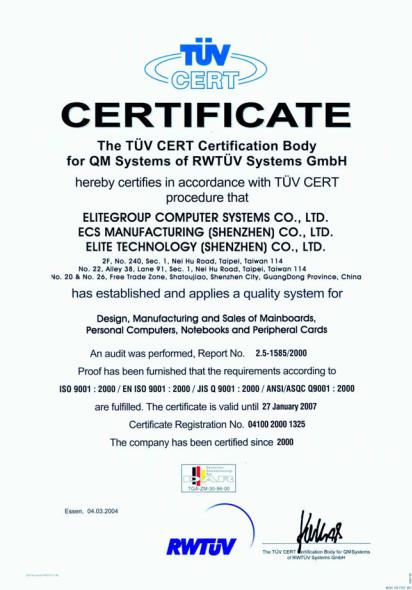

Preface
Copyright
This publication, including all photographs, illustrations and software, is protected under international copyright laws, with all rights reserved. Neither this manual, nor any of the material contained herein, may be reproduced without written consent of the author.
Version 1.0
Disclaimer
The information in this document is subject to change without notice. The manufacturer makes no representations or warranties with respect to the contents hereof and specifically disclaims any implied warranties of merchantability or fitness for any particular purpose. The manufacturer reserves the right to revise this publication and to make changes from time to time in the content hereof without obligation of the manufacturer to notify any person of such revision or changes.
Trademark Recognition
Microsoft, MS-DOS and Windows are registered trademarks of Microsoft Corp.
AMD, Athlon, Sempron and Duron are registered trademarks of AMD Corporation.
Other product names used in this manual are the properties of their respective owners and are acknowledged.
Federal Communications Commission (FCC)
This equipment has been tested and found to comply with the limits for a Class B digital device, pursuant to Part 15 of the FCC Rules. These limits are designed to provide reasonable protection against harmful interference in a residential installation. This equipment generates, uses, and can radiate radio frequency energy and, if not installed and used in accordance with the instructions, may cause harmful interference to radio communications. However, there is no guarantee that interference will not occur in a particular installation. If this equipment does cause harmful interference to radio or television reception, which can be determined by turning the equipment off and on, the user is encouraged to try to correct the interference by one or more of the following measures:
•Reorient or relocate the receiving antenna
•Increase the separation between the equipment and the receiver
•Connect the equipment onto an outlet on a circuit different from that to which the receiver is connected
•Consult the dealer or an experienced radio/TV technician for help
Shielded interconnect cables and a shielded AC power cable must be employed with this equipment to ensure compliance with the pertinent RF emission limits governing this device. Changes or modifications not expressly approved by the system’s manufacturer could void the user’s authority to operate the equipment.
Preface
ii
Declaration of Conformity
This device complies with part 15 of the FCC rules. Operation is subject to the following conditions:
•This device may not cause harmful interference, and
•This device must accept any interference received, including interference that may cause undesired operation
Canadian Department of Communications
This class B digital apparatus meets all requirements of the Canadian Interference-causing Equipment Regulations.
Cet appareil numérique de la classe B respecte toutes les exigences du Réglement sur le matériel brouilieur du Canada.
About the Manual
The manual consists of the following:
Chapter 1
Introducing the Motherboard
Chapter 2
Installing the Motherboard
Chapter 3
Using BIOS
Chapter 4
Using the Motherboard Software
Describes features of the motherboard. Go to H page 1
Describes installation of motherboard components.
Go to H page 7
Provides information on using the BIOS Setup Utility.
Go to |
H page 27 |
Describes the motherboard software
Go to |
H page 47 |
Preface

iii
TABLE OF CONTENTS |
|
Preface |
i |
Chapter 1 |
1 |
Introducing the Motherboard |
1 |
Introduction................................................................................................. |
1 |
Feature.......................................................................................................... |
2 |
Motherboard Components........................................................................ |
4 |
Chapter 2 |
7 |
Installing the Motherboard |
7 |
Safety Precautions...................................................................................... |
7 |
Choosing a Computer Case....................................................................... |
7 |
Installing the Motherboard in a Case...................................................... |
7 |
Checking Jumper Settings......................................................................... |
8 |
Setting Jumpers.............................................................................. |
8 |
Checking Jumper Settings.............................................................. |
9 |
Jumper Settings.............................................................................. |
9 |
Connecting Case Components............................................................... |
10 |
Front Panel Connector................................................................. |
12 |
Installing Hardware................................................................................... |
13 |
Installing the Processor............................................................... |
13 |
Installing Memory Modules......................................................... |
15 |
Installing a Hard Disk Drive/CD-ROM/SATA Hard Drive........ |
17 |
Installing a Floppy Diskette Drive............................................... |
19 |
Installing Add-on Cards.............................................................. |
20 |
Connecting Optional Devices...................................................... |
22 |
Connecting I/O Devices.......................................................................... |
26 |
Chapter 3 |
27 |
Using BIOS |
27 |
About the Setup Utility............................................................................ |
27 |
The Standard Configuration........................................................ |
27 |
Entering the Setup Utility.............................................................. |
27 |
Updating the BIOS....................................................................... |
29 |
Using BIOS................................................................................................ |
29 |
Standard CMOS Features........................................................... |
30 |
Advanced BIOS Features............................................................. |
32 |
Advanced Chipset Features......................................................... |
34 |
iv
Integrated Peripherals................................................................. |
36 |
Power Management Setup........................................................... |
40 |
PNP/PCI Configurations............................................................. |
42 |
PC Health Status.......................................................................... |
43 |
Frequency/Voltage Control.......................................................... |
44 |
Load Fail-Safe Settings................................................................ |
45 |
Load Optimized Defaults............................................................. |
45 |
Set Supervisor/User Password.................................................... |
45 |
Save & Exit Setup......................................................................... |
46 |
Exit Without Saving...................................................................... |
46 |
Chapter 4 |
47 |
Using the Motherboard Software |
47 |
About the Software CD-ROM................................................................ |
47 |
Auto-installing under Windows 2000/XP............................................. |
47 |
Running Setup.............................................................................. |
48 |
Manual Installation.................................................................................. |
50 |
Utility Software Reference....................................................................... |
50 |
Multi-Language Translation

1
Chapter 1
Introducing the Motherboard
Introduction
Thank you for choosing the RS482-M motherboard. This motherboard is a high performance, enhanced function motherboard that supports Socket 939 AMD Sempron/Athlon 64/Athlon 64 FX CPUs for high-end business or personal desktop markets.
The motherboard incorporates the RS482 Northbridge (NB) and SB400 Southbridge (SB) chipsets. The Northbridge supports the HyperTransport (HT) interface speeds up to 2000MT/s data rate. RS482 integrated an ATI RADEON X300-based graphics core, coupled with a high speed HyperTransport interface for optimal 3D performance. This motherboard supports two DDR Sockets with maximum memory size of 2 GB. One PCI Express x16 slot, intended for Graphics Interface, is fully compliant to the PCI Express Base Specification revision 1.0a.
The SB400 Southbridge supports three PCI slots which are PCI 2.3 compliant. It implements an EHCI compliant interface that provides 480Mb/s bandwidth for eight USB 2.0 ports (rear panel x 4, header x 4). Two onboard IDE connectors supports 4 IDE devices in UDMA 133/100/66/33 mode. The Southbridge integrates a Serial ATA host controller that is SATA v1.0 compliant, supporting four SATA ports with maximum transfer rate up to 150 MB/s each.
The RS482-M motherboard is equipped with advanced full set of I/O ports in the rear panel, including PS/2 mouse and keyboard connectors, COM1, LPT1, VGA, four USB ports, one optional LAN port, and audio jacks for microphone, line-in and line-out.
Introducing the Motherboard
2
Feature
Processor
The RS482-M uses an 939-pin socket that carries the following features:
•Accommodates AMD Sempron/Athlon64/Athlon 64 FX processors
•Supports up to 2000MT/s HyperTransportTM (HT) interface speeds
HyperTransportTM Technology is a point-to-point link between two devices, it enables integrated circuits to exchange information at much higher speeds than currently available interconnect technologies.
Chipset
The RS482 Northbridge (NB) and SB400 Southbridge (SB) chipsets are based on an innovative and scalable architecture with proven reliability and performance.
RS482 (NB) |
• |
1 x2 (expandable to x4) A-Link Express interface (PCI Ex- |
|
|
press 1.0a compliant) for connection to the ATI IXP |
|
• |
Supports one PCI Express x16 for Graphics Interface, fully |
|
|
compliant to the PCI Express Base Specification revision |
|
|
1.0a. |
|
• |
Full support for 3D primitive, Direct3D texture lighting, and |
|
|
OpenGL format for Indirect Vertices in Vertex Walker |
|
• |
Full DirectX 9.0 support (Vertex Shader version 2.0 and |
|
|
Pixel Shader version 2.0) |
SB400 (SB) |
• |
2-lane A-Link Express interface (PCI Express 1.0a compli- |
|
|
ant) to RADEON IGPs |
|
• |
Compliant with PCI 2.3 specificaiton, up to 7 bus master |
|
|
devices supported |
|
• |
Four Serial ATA devices supported, compliant with Serial |
|
|
ATA 1.0 specification, RAID 0 and RAID 1 accommodated |
|
• |
Integrated USB 2.0 Host Controller supporting up to eight |
|
|
USB 2.0 ports |
|
• |
Integrated IDE controller supports Ultra DMA 133/100/66/33 |
|
|
modes |
Memory |
|
|
•DDR 400/333/266 DDR SDRAM with Dual Channel supported
•Accommodates two unbuffered DIMMs, up to 2 GB maximum memory size
Audio
•Compliant with AC’97 2.3 specification
•16-bit Stereo full-duplex CODEC with 48KHz sampling rate
•Supports double sampling rate (96KHz) of DVD audio playback
•Direct Sound 3DTM compatible
1394a FireWire (Optional)
•Fully compliant with provisions of IEEE Std 1394-1995 for a high-perfor- mance serial bus and IEEE Std 1394a-2000
•Two IEEE Std 1394a-2000 fully compliant cable ports at 400M bits/s
Introducing the Motherboard

3
Onboard LAN (Optional)
This motherboard may support either of the following LAN with following features:
•Support 10/100 Mbps N-way Auto-negotiation operation
•Supports Wake-On-LAN function and remote wake-up
•Supports LED pins for various network activity indications
•Supports Full Duplex Flow Control (IEEE 802.3x)
•Integrated 10/100/1000 transceiver
•Supports PCI rev. 2.3, 32-bit, 33/66MHz
•Crossover Detection & Auto-Correction
•Wake-on-LAN and remote wake-up support
Expansion Options
The motherboard comes with the following expansion options:
•One PCI Express x16 for Graphic Interface
•Three 32-bit PCI v2.3 compliant slots
•Two 40-pin IDE connectors supporting up to 4 IDE devices
•One floppy disk drive interface
•Four 7-pin SATA connector
The RS482-M motherboard supports UltraDMA bus mastering with transfer rates of 133/100/66/33 MB/s.
Integrated I/O
The motherboard has a full set of I/O ports and connectors:
•Two PS/2 ports for mouse and keyboard
•One serial port
•One parallel port
•One VGA port
•Four USB ports
•One 1394a port (optional)
•One LAN port (optional)
•Audio jacks for microphone, line-in and line-out
BIOS Firmware
This motherboard uses AWARD BIOS that enables users to configure many system features including the following:
•Power management
•Wake-up alarms
•CPU parameters
•CPU and memroy timing
The firmware can also be used to set parameters for different processor clock speeds.
Some hardware specifications and software items are subject to change with out prior notice.
Introducing the Motherboard
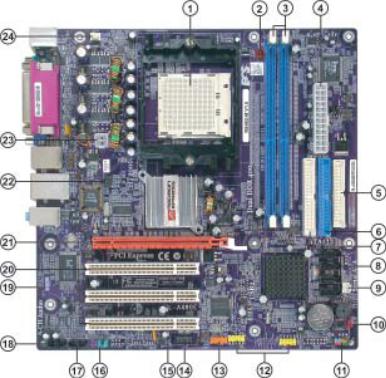
4
Motherboard Components
Introducing the Motherboard

5
Table of Motherboard Components
LABEL |
COMPONENT |
||
1 CPU Socket |
Socket 939 for AMD K8 processor |
||
2 CPU_FAN |
CPU cooling fan connector |
||
3 DIMM1~2 |
184-pin DDR SDRAM slots |
||
4 ATX_POWER |
Standard 24-pin ATX power connector |
|
|
5 FDD |
Floppy diskette drive connector |
|
|
6 IDE1 |
Primary IDE channel |
||
7 IDE2 |
Secondary IDE channel |
||
8 SATA1~4 |
Serial ATA connectors |
||
9 PWR_FAN |
Power fan connector |
|
|
10 CLR_CMOS |
Clear CMOS jumper |
||
11 PANEL1 |
Front panel switch/LED header |
||
12 USB3-4 |
Front Panel USB headers |
||
13 1394A2* |
Onboard 1394a header |
||
14 COM2* |
Onboard serial port header |
||
15 BIOS_WP |
BIOS protection jumper |
||
16 AUDIO1 |
Front panel audio header |
||
17 CD_IN |
Analog audio input connector |
||
18 AUX_IN* |
Auxliary-in header |
|
|
19 SPDIFO1 |
SPDIF out header |
||
20 PCI1~3 |
32-bit add-on card slots |
||
21 PCIEX16 |
PCI Express x16 graphics card slot |
||
22 TV_OUT* |
TV-out header |
||
23 ATX12V |
4-pin +12V power connector |
||
24 SYS_FAN* |
System cooling fan connector |
||
“*” stands for optional components. |
|
|
|
This concludes Chapter 1. The next chapter explains how to install the motherboard.
Introducing the Motherboard
6
Memo
Introducing the Motherboard

7
Chapter 2
Installing the Motherboard
Safety Precautions
•Follow these safety precautions when installing the motherboard
•Wear a grounding strap attached to a grounded device to avoid damage from static electricity
•Discharge static electricity by touching the metal case of a safely grounded object before working on the motherboard
•Leave components in the static-proof bags they came in
•Hold all circuit boards by the edges. Do not bend circuit boards
Choosing a Computer Case
There are many types of computer cases on the market. The motherboard complies with the specifications for the Micro-ATX system case. First, some features on the motherboard are implemented by cabling connectors on the motherboard to indicators and switches on the system case. Make sure that your case supports all the features required. Secondly, RS482-M supports one or two floppy diskette drives and four enhanced IDE drives. Make sure that your case has sufficient power and space for all drives that you intend to install.
Most cases have a choice of I/O templates in the rear panel. Make sure that the I/O template in the case matches the I/O ports installed on the rear edge of the motherboard.
This motherboard carries a Micro-ATX form factor of 244 x 244 mm. Choose a case that accommodates this form factor.
Installing the Motherboard in a Case
Refer to the following illustration and instructions for installing the motherboard in a case.
Most system cases have mounting brackets installed in the case, which correspond the holes in the motherboard. Place the motherboard over the mounting brackets and secure the motherboard onto the mounting brackets with screws.
Ensure that your case has an I/O template that supports the I/O ports and expansion slots on your motherboard.
Installing the Motherboard
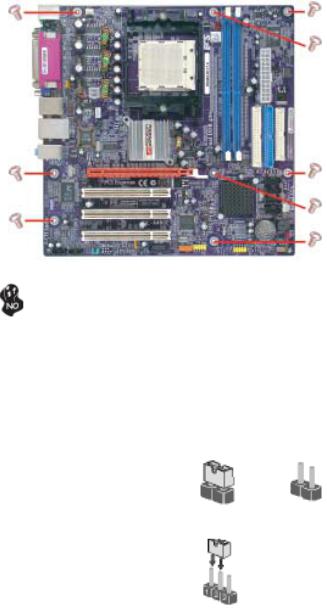
8
Do not over-tighten the screws as this can stress the motherboard.
Checking Jumper Settings
This section explains how to set jumpers for correct configuration of the motherboard.
Setting Jumpers
Use the motherboard jumpers to set system configuration options. Jumpers with more than one pin are numbered. When setting the jumpers, ensure that the jumper caps are placed on the correct pins.
The illustrations show a 2-pin jumper. When |
|
|
the jumper cap is placed on both pins, the |
|
|
jumper is SHORT. If you remove the jumper |
|
|
cap, or place the jumper cap on just one pin, |
|
|
the jumper is OPEN. |
SHORT |
OPEN |
|
This illustration shows a 3-pin jumper. Pins 1 and 2 are SHORT
Installing the Motherboard

9
Checking Jumper Settings
The following illustration shows the location of the motherboard jumpers. Pin 1 is labeled.
Jumper Settings
Jumper |
Type |
Description |
Setting (default) |
|
|
|
|
|
|
|
1-2: CLEAR |
CLR_CMOS |
|||
|
|
|
2-3: NORMAL |
||||
CLR_CMOS |
3-pin |
CLEAR CMOS |
|
|
|
|
|
|
|
|
|
||||
Before clearing the |
|
|
1 |
||||
|
|
|
|
|
|||
|
|
|
CMOS, make sure to |
|
|
||
|
|
|
turn off the system. |
|
|
|
|
BIOS_WP |
2-pin |
BIOS WRITE |
OPEN: ENABLE |
BIOS_WP |
|||
SHORT: DISABLE |
|
|
|
1 |
|||
|
|
|
|||||
|
|
|
|
|
|
||
|
|
|
|
|
|
||
|
|
|
|
|
|
||
|
|
|
|
|
|
|
|
Installing the Motherboard
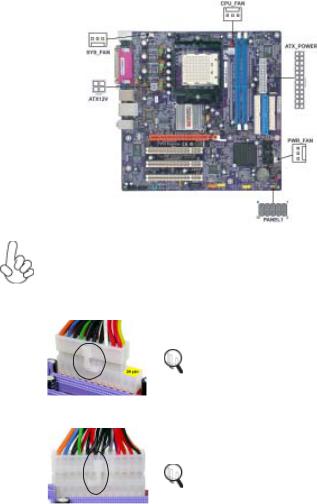
10
Connecting Case Components
After you have installed the motherboard into a case, you can begin connecting the motherboard components. Refer to the following:
1Connect the CPU cooling fan cable to CPU_FAN.
2Connect the system cooling fan connector to SYS_FAN.
3Connect the power fan connector to PWR_FAN.
4Connect the case switches and indicator LEDs to the PANEL1.
5Connect the standard power supply connector to ATX_POWER.
6Connect the auxiliary case power supply connector to ATX12V.
Connecting 20/24-pin power cable
Users please note that the 20-pin and 24-pin power cables can both be connected to the ATX1 connector. With the 20-pin power cable, just align the 20pin power cable with the pin 1 of the ATX1 connector. However, using 20-pin power cable may cause the system to become unbootable or unstable because of insufficient electricity.
|
|
|
With ATX v1.x power supply, users please |
|
|
|
|
||
|
|
|
note that when installing 20-pin power cable, |
|
|
|
|
the latche of power cable |
clings to the left |
20-pin power cable |
side of the ATX_POWER connector latch, |
|||
just as the picture shows. |
|
|||
|
|
|
With ATX v2.x power supply, users please |
|
|
|
|
note that when installing 24-pin power cable, |
|
|
|
|
||
|
|
|
the latches of power cable |
clings to the right |
|
|
|
side of the ATX_POWER connector latch. |
|
24-pin power cable
Installing the Motherboard
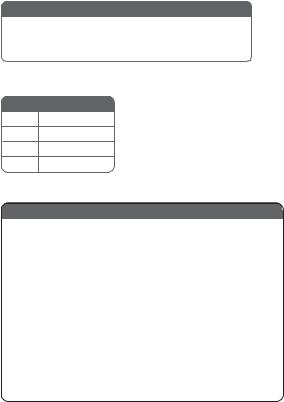
11
CPU_FAN/SYS_FAN/PWR_FAN: FAN Power Connectors
Pin |
Signal Name |
Function |
1 |
GND |
System Ground |
2 |
+12V |
Power +12V |
3 |
Sense |
Sensor |
ATX12V: ATX 12V Power Connector
Pin |
Signal Name |
1Ground
2Ground
3+12V
4+12V
ATX_POWER: ATX 24-pin Power Connector
Pin |
Signal Name |
Pin |
Signal Name |
|
1 |
+3.3V |
13 |
+3.3V |
|
2 |
+3.3V |
14 |
-12V |
|
3 |
Ground |
15 |
GND |
|
4 |
+5V |
16 |
PS_ON |
|
5 |
Ground |
17 |
GND |
|
6 |
+5V |
18 |
GND |
|
7 |
Ground |
19 |
GND |
|
8 |
PWRGD |
20 |
-5V |
|
9 |
+5VSB |
21 |
+5V |
|
10 |
+12V |
22 |
+5V |
|
11 |
+12V |
23 |
+5V |
|
|
|
|
|
|
12 |
+3.3V |
24 |
GND |
|
|
|
|
|
|
Installing the Motherboard
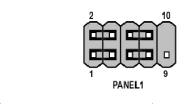
12
Front Panel Connector
The front panel connector (PANEL1) provides a standard set of switch and LED connectors commonly found on ATX or micro-ATX cases. Refer to the table below for information:
Pin |
Signal |
Function |
Pin |
Signal |
Function |
1 |
HD_LED_P |
Hard disk LED(+) |
2 |
FP PWR/SLP |
*MSG LED(+) |
|
|
|
|
|
|
3 |
HD_LED_N |
Hard disk LED(-) |
4 |
FP PWR/SLP |
*MSG LED(-) |
|
|
|
|
|
|
5 |
RST_SW_N |
Reset Switch(-) |
6 |
PWR_SW_P |
Power Switch(+) |
|
|
|
|
|
|
7 |
RST_SW_P |
Reset Switch(+) |
8 |
PWR_SW_N |
Power Switch(-) |
|
|
|
|
|
|
9 |
RSVD |
Reserved |
10 |
Key |
Nopin |
|
|
|
|
|
|
* MSG LED (dual color or single color)
Hard Drive Activity LED
Connecting pins 1 and 3 to a front panel mounted LED provides visual indication that data is being read from or written to the hard drive. For the LED to function properly, an IDE drive should be connected to the onboard IDE interface. The LED will also show activity for devices connected to the SATA (hard drive activity LED) connector.
Power/Sleep/Message waiting LED
Connecting pins 2 and 4 to a single or dual-color, front panel mounted LED provides power on/off, sleep, and message waiting indication.
Reset Switch
Supporting the reset function requires connecting pin 5 and 7 to a momentary-contact switch that is normally open. When the switch is closed, the board resets and runs POST.
Power Switch
Supporting the power on/off function requires connecting pins 6 and 8 to a momentarycontact switch that is normally open. The switch should maintain contact for at least 50 ms to signal the power supply to switch on or off. The time requirement is due to internal debounce circuitry. After receiving a power on/off signal, at least two seconds elapses before the power supply recognizes another on/off signal.
Installing the Motherboard

13
Installing Hardware
Installing the Processor
Caution: When installing a CPU heatsink and cooling fan make sure that you DO NOT scratch the motherboard or any of the surface-mount resistors with the clip of the cooling fan. If the clip of the cooling fan scrapes across the motherboard, you may cause serious damage to the motherboard or its components.
On most motherboards, there are small surface-mount resistors near the processor socket, which may be damaged if the cooling fan is carelessly installed.
Avoid using cooling fans with sharp edges on the fan casing and the clips. Also, install the cooling fan in a well-lit work area so that you can clearly see the motherboard and processor socket.
Before installing the Processor
This motherboard automatically determines the CPU clock frequency and system bus frequency for the processor. You may be able to change these settings by making changes to jumpers on the motherboard, or changing the settings in the system Setup Utility. We strongly recommend that you do not over-clock processors or other components to run faster than their rated speed.
Warning: Over-clocking components can adversely affect the reliability of the system and introduce errors into your system. Over-clocking can permanently damage the motherboard by generating excess heat in components that are run beyond the rated limits.
This motherboard has a Socket 939 porcessor socket. When choosing a processor, consider the performance requirements of the system. Performance is based on the processor design, the clock speed and system bus frequency of the processor, and the quantity of internal cache memory and external cache memory.
Installing the Motherboard
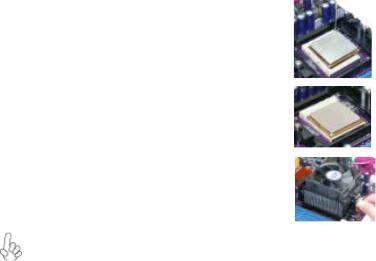
14
CPU Installation Procedure
The following illustration shows CPU installation components.
1Install your CPU. Pull up the lever away from the socket and lift up to 90-degree angle.
2Locate the CPU cut edge (the corner with the pin hold noticeably missing). Align and insert the CPU correctly.
3Press the lever down and apply thermal grease on top of the CPU.
4Put the CPU Fan down on the retention module and snap the four retention legs of the cooling fan into place.
5Flip the levers over to lock the heat sink in place and connect the CPU cooling Fan power cable to the CPUFAN connector. This completes the installation.
To achieve better airflow rates and heat dissipation, we suggest that you use a high quality fan with 4800 rpm at least. CPU fan and heatsink installation procedures may vary with the type of CPU fan/heatsink supplied. The form and size of fan/heatsink may also vary.
Installing the Motherboard
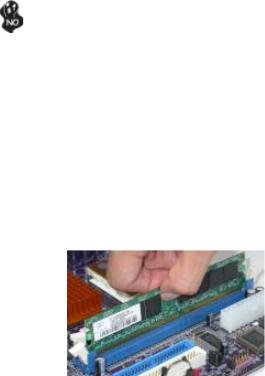
15
Installing Memory Modules
This motherboard accomodates two memory modules. It can support two 184-pin 2.5V unbuffered DIMM, DDR 400/333/266. The maximum memory capacity is 2GB.
DDR SDRAM memory module table
Memory module |
Memory Bus |
DDR 266 |
133MHz |
DDR 333 |
166MHz |
DDR 400 |
200MHz |
You must install at least one module in any of the two slots. Each module can be installed with 256MB to 1GB of memory. Based on Dual DDR structure, when only one DDR
SDRAM DIMM is available, please insert it to DIMM1 slot, rather than DIMM2 slot, in case that the system may not boot.
Do not remove any memory module from its antistatic packaging until you are ready to install it on the motherboard. Handle the modules only by their edges. Do not touch the components or metal parts. Always wear a grounding strap when you handle the modules.
Installation Procedure
Refer to the following to install the memory modules.
1This motherboard supports unbuffered DDR SDRAM .
2Push the latches on each side of the DIMM slot down.
3Align the memory module with the slot. The DIMM slots are keyed with notches and the DIMMs are keyed with cutouts so that they can only be installed correctly.
4Check that the cutouts on the DIMM module edge connector match the notches in the DIMM slot.
5Install the DIMM module into the slot and press it firmly down until it seats correctly. The slot latches are levered upwards and latch on to the edges of the DIMM.
6Install any remaining DIMM modules.
Installing the Motherboard

16
Table A: DDR 400 QVL (Qualified Vendor List)
|
Size |
Vendor |
Model Name |
|
|
256MB |
|
APACER |
AM3A568ACT05A |
|
|
|
CORSAIR |
PLATNUM CMX512-3200C2PT |
|
|
|
GEIL |
GE08L3264D1WL5NKT3H71 |
|
|
|
GEIL |
G208L364D1TG5NKT3C |
|
|
|
Hynix |
HY5DU56822BT-D43 |
|
|
|
Kingston |
D3208DL2T-5 0323PT01 |
|
|
|
Kingston |
Samsung K4H560838D-TCC4 |
|
|
|
Kingston |
Winbond W942508BH-5 |
|
|
|
Ramaxel |
MIC-R 46V32M8TG-5BC |
|
|
|
Ramaxel |
Samsung K4H560838D-TCC4 |
|
|
|
Samsung |
K4H560838D-TCCC |
|
|
|
Soutec |
M2G9108AKAS09F083S9DT |
|
512MB |
|
CORSAIR |
PLATNUM CMX512-3200C2PT |
|
|
|
GEIL |
GE16L6464D2WL5NKT3H66 |
|
|
|
Kingmax |
KDL388P4EA-50 |
|
|
|
Kingston |
Samsung K4H560838D-TCC4 |
|
|
|
Kingston |
Winbond W942508BH-5 |
|
|
|
Samsung |
K4H560838E-TCCC |
|
|
|
TwinMOS |
M2G9J16AKATT9F083S9DT |
Table B: Unbuffered DIMM Support for 939-pin
Data |
Chip Selects |
|
|
Maximum |
||||
|
|
DRAM Speed |
||||||
Bus |
|
|
|
|
||||
|
|
|
|
|
|
|
||
|
MEMCS_1L_L* |
MEMCS_1H_L* |
MEMCS_2L_L* |
MEMCS_2H_L* |
1T |
2T |
||
|
|
|
|
|
|
|
||
|
Single rank |
N/A |
N/A |
N/A |
DDR400 DDR400 |
|||
|
Double rank |
N/A |
N/A |
N/A |
DDR400 DDR400 |
|||
|
|
|
|
|
|
|
||
|
N/A |
N/A |
Single rank |
N/A |
DDR400 DDR400 |
|||
|
|
|
|
|
|
|
||
64- |
N/A |
N/A |
Double rank |
N/A |
DDR400 DDR400 |
|||
|
|
|
|
|
|
|
||
Single rank |
N/A |
Single rank |
N/A |
DDR333 DDR400 |
|
|||
bits |
||||||||
Single rank |
N/A |
Double rank |
N/A |
DDR200 DDR400 |
||||
|
||||||||
|
Double rank |
N/A |
Single rank |
N/A |
DDR200 DDR400 |
|||
|
|
|
|
|
|
|
||
|
Double rank |
N/A |
Double rank |
N/A |
DDR200 DDR333 |
|||
|
|
|
|
|
|
|
||
|
Single rank |
Single rank |
N/A |
N/A |
DDR400 DDR400 |
|||
|
Double rank |
Double rank |
N/A |
N/A |
DDR400 DDR400 |
|||
|
N/A |
N/A |
Single rank |
Single rank |
DDR400 DDR400 |
|||
128- |
|
|
|
|
|
|
||
N/A |
N/A |
Double rank |
Double rank |
DDR400 DDR400 |
||||
bits |
Single rank |
Single rank |
Single rank |
Single rank |
DDR333 DDR400 |
|||
|
Single rank |
Single rank |
Double rank |
Double rank |
DDR200 DDR400 |
|
||
|
Double rank |
Double rank |
Single rank |
Single rank |
DDR200 DDR400 |
|||
|
Double rank |
Double rank |
Double rank |
Double rank |
DDR200 DDR333 |
|||
Note for “*”: Memory types must be set to values consistent with system hardware.
Installing the Motherboard
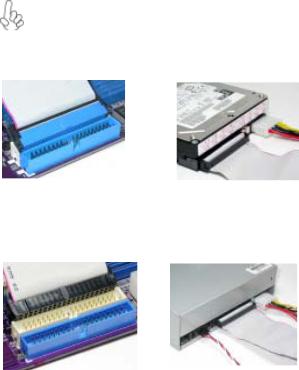
17
Installing a Hard Dish Drive/CD-ROM/SATA Hard Drive
This section describes how to install IDE devices such as a hard disk drive and a CD-ROM drive.
About IDE Devices
Your motherboard has two IDE channel interfaces (IDE1 & IDE2). Two IDE ribbon cables supporting four IDE devices is bundled with the motherboard.
You must orient the cable connector so that the pin1 (color) edge of the cable correspoinds to the pin 1 of the I/O port connector.
IDE1: Primary IDE Connector
The first hard drive should always be connected to IDE1.
IDE2: Secondary IDE Connector
The second drive on this controller must be set to slave mode. The cinfiguration is the same as IDE1.
IDE devices enclose jumpers or switches used to set the IDE device as MASTER or SLAVE. Refer to the IDE device user’s manual. Installing two IDE devices on one cable, ensure that one device is set to MASTER and the other device is set to SLAVE. The documentation of your IDE device explains how to do this.
Installing the Motherboard
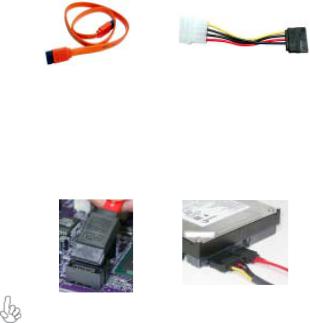
18
About SATA Connectors
This motherboard features four SATA connectors supporting a total of four drives. SATA , or Serial ATA (Advanced Technology Attachment) is the standard interface for the IDE hard drives which are currently used in most PCs. These connectors are well designed and will only fit in one orientation. Locate the SATA connectors on the motherboard and follow the illustration below to install the SATA hard drives.
Installing Serial ATA Hard Drives
To install the Serial ATA (SATA) hard drives, use the SATA cable that supports the Serial ATA protocol. This SATA cable comes with an SATA power cable. You can connect either end of the SATA cable to the SATA hard drive or the connector on the motherboard.
SATA cable (optional) |
SATA power cable (optional) |
Refer to the illustration below for proper installation:
1Attach either cable end to the connector on the motherboard.
2Attach the other cable end to the SATA hard drive.
3Attach the SATA power cable to the SATA hard drive and connect the other end to the power supply.
This motherboard does not support the “Hot-Plug” function.
Installing the Motherboard
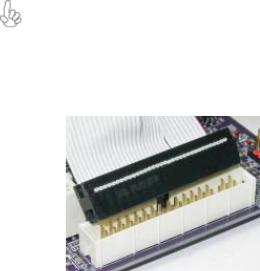
19
Installing a Floppy Diskette Drive
The motherboard has a floppy diskette drive (FDD) interface and ships with a diskette drive ribbon cable that supports one or two floppy diskette drives. You can install a 5.25-inch drive and a 3.5-inch drive with various capacities. The floppy diskette drive cable has one type of connector for a 5.25-inch drive and another type of connector for a 3.5-inch drive.
You must orient the cable connector so that the pin 1 (color) edge of the cable corresponds to the pin 1 of the I/O port connector.
FDD: Floppy Disk Connector
This connector supports the provided floppy drive ribbon cable. After connecting the single end to the onboard floppy connector, connect the remaining plugs on the other end to the floppy drives correspondingly.
Installing the Motherboard
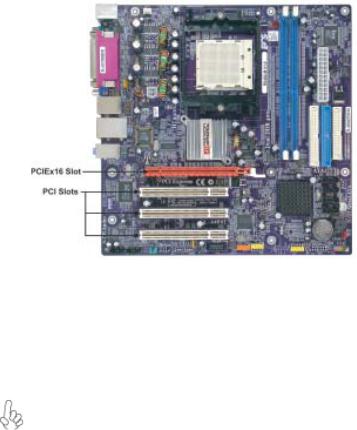
20
Installing Add-on Cards
The slots on this motherboard are designed to hold expansion cards and connect them to the system bus. Expansion slots are a means of adding or enhancing the motherboard’s features and capabilities. With these efficient facilities, you can increase the motherboard’s capabilities by adding hardware that performs tasks that are not part of the basic system.
PCIEX16
Slot
PCI 1~3
Slots
The PCI Express x16 slot is used to install an external PCI Express graphics card that is fully compliant to the PCI Express Base Specification revision 1.0a.
This motherboard is equipped with three standard PCI slots. PCI stands for Peripheral Component Interconnect and is a bus standard for expansion cards, which for the most part, is a supplement of the older ISA bus standard. The PCI slots on this board are PCI v2.3 compliant.
Before installing an add-on card, check the documentation for the card carefully. If the card is not Plug and Play, you may have to manually configure the card before installation.
Installing the Motherboard
